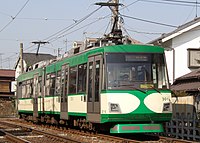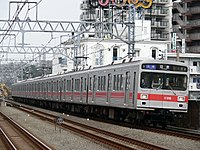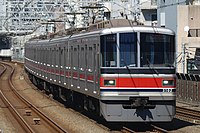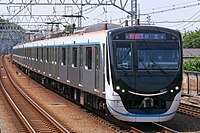Tokyu Corporation
 | |
| Tokyu, Tōkyū Dentetsu, Tōkyō Kyūkō (before 2006), TKK (from Tokyo Kyuko Kabushikigaisha) | |
Native name | 東急株式会社 |
Romanized name | Tōkyū kabushiki-gaisha |
| Formerly | 東京急行電鉄株式会社 Tōkyō Kyūkō Dentetsu KK (1 May 1942-1 Sep 2019) |
| Type | Public K.K. |
| |
| Industry | Conglomerate |
| Predecessor |
|
| Founded | May 16, 1910 (as Musashi Electric Railway Company; renamed Tokyo-Yokohama Electric Railway in October 25, 1924) September 2, 1922 (Meguro-Kamata Electric Railway) October 16, 1939 (current iteration of company) Renamed Tokyu in May 1, 1942 |
| Founder | Keita Goto |
| Headquarters | 5-6 Nanpeidaicho, Shibuya-ku, Tokyo , Japan |
Area served | Tokyo and Kanagawa. |
Key people | President-Director Chairperson Representative Director Kiyobumi Kamijo Toshiaki Koshimura |
| Services | passenger railways other related services |
| Owner | Dai-ichi Life (5.55%) |
| Parent | Tokyu Group |
| Website | www |
 | |
| Tokyu, Tōkyū Dentetsu, Tōkyō Kyūkō (before 2006), TKK (from Tokyo Kyuko Kabushikigaisha) | |
Native name | 東急電鉄株式会社 |
Romanized name | Tōkyū Dentetsu kabushiki gaisha |
| Type | Subsidiary |
| Industry | Private railroad |
| Founded | April 25, 2019 (incorporation) October 1, 2019 (effective reorganization) |
| Founder | Keita Goto |
| Headquarters | 5-6 Nanpeidaicho, Shibuya-ku, Tokyo , Japan |
Area served | Tokyo and Kanagawa. |
Key people | Hirofumi Nomoto (CEO) |
| Services | passenger railways other related services |
| Owner | Tokyu Group |
| Parent | Tokyu Corporation |
| Website | www |
The Tokyu Corporation (東急株式会社, Tōkyū kabushiki-gaisha, a contraction of and formerly Tōkyō Kyūkō Dentetsu kabushiki gaisha (東京急行電鉄株式会社, "Tokyo Express Electric Railway Share Company") until 2 September 2019) is a Japanese multinational keiretsu (conglomerate) holding company headquartered in Shibuya, Tokyo. Its main operation is the Tokyu Railways Company, Ltd.[1] (東急電鉄株式会社, Tōkyū Dentetsu kabushiki gaisha), a wholly owned subsidiary operating railways in the Greater Tokyo Area.
History[]



The oldest predecessor of company was the Musashi Electric Railway (武蔵電気鉄道, Musashi Denki Tetsudō), opened in 1908; the railway's operations were converted into a company in 1910. Keita Gotō, now known as a notable Japanese industrialist, was appointed as the CEO of the Musashi Electric Railway in 1920 and later he began a mass expansion program. The most important predecessor was first registered on September 2, 1922, as the Meguro-Kamata Electric Railway (目黒蒲田電鉄, Meguro-Kamata Dentetsu) and is related to the construction of Den-en-chōfu (it was originally founded by the developers of Den-en-chōfu); it was acquired by the Musashi Electric Railway in 1924, shortly before Musashi was renamed into the Tokyo-Yokohama Electric Railway (東京横浜電鉄, Tōkyō-Yokohama Dentetsu), also known as the Toyoko, in the same year.
After Musashi/Toyoko's acquisition, the Meguro-Kamata Electric Railway initially operated as a subsidiary of Toyoko. It was not until 16 October 1939 that both Toyoko and Meguro-Kamata Electric railways were formally merged; the new company took the Toyoko name.
In 1938, Toyoko established Toyoko Eiga [ja], possibly for competition with Ichizo Kobayashi's Toho Company. It became the Toei Company in 1951.
Toyoko took its current name on 1 May 1942, after the Japanese government forced the company to acquire the Odawara Express Railway and the Keihin Electric Railway in 1943 to support Japan's efforts in World War II. In 1944 it also acquired the Keio Teito Electric Railway (which has merged with Odawara Express before in 1940). In 1948, Tokyu divested the forced-acquired companies, and the divested companies are now known as Odakyu Electric Railway, Keikyu Corporation, and Keio Corporation respectively. The 1943–1948 era of Tokyu was colloquially known as Dai-Tokyu (lit. Great Tokyu).
Tokyu lines[]
| Line | Symbol | Route | Length (km) | Stations | Date opened | Max speed (km/h) |
|---|---|---|---|---|---|---|
| Tōyoko Line | TY | Shibuya – Yokohama | 24.2 | 21 | 1926 | 110 |
| Meguro Line | MG | Meguro – Hiyoshi | 11.9 | 13 | 1923 | 110 |
| Den-en-toshi Line | DT | Shibuya – Chūō-Rinkan | 31.5 | 27 | 1907 | 110 |
| Ōimachi Line | OM | Ōimachi – Mizonokuchi | 10.4 | 15 | 1927 | 85 |
| Ikegami Line | IK | Gotanda – Kamata | 10.9 | 15 | 1922 | 80 |
| Setagaya Line | SG | Sangen-Jaya – Shimo-Takaido | 5.0 | 10 | 1925 | 40 |
| Tōkyū Tamagawa Line | TM | Kamata – Tamagawa | 5.6 | 7 | 2000 | 80 |
| Total (7 lines) | 99.5 | 96 |

Tokyu also operates the KD Kodomonokuni Line (Nagatsuta Station – Kodomonokuni Station, 3.4 km) under contract with and on behalf of Yokohama Minatomirai Railway Company.
Related businesses[]
The Tokyu Group also owns two smaller railroad companies (Ueda Kōtsū, Izukyū Corporation), several bus companies and a major upscale department store chain called Tokyu operating in Japan and in the MBK Center in Bangkok, Thailand. Other retail operations include Tokyu Hands stores (except for the two locations in Nagoya, which are owned by Sanco Creative Life Co. (indirectly controlled by Kintetsu Group Holdings), and operated under license). It also runs a number of hotels under the names Tokyu/Pan Pacific in Japan and formerly owned the Pan Pacific Hotels abroad, which it sold to UOL Limited of Singapore.
Formerly the owner of Japan Air System (JAS, now merged with the flag carrier JAL Japan), Tokyu used to be the largest shareholder of Japan Airlines Holdings (JAL) following JAS's merger with JAL. The Tokyu Group also owns and operates the upscale Tokyu Hotels and budget Tokyu Inns.
From 1958 until 2001, Tokyu also owned the Japanese (now American) Shirokiya department store company. It was the owner of Mago Island until 2005, when Mel Gibson purchased it for US$15 million.[citation needed]
Rolling stock[]
- Tokyu 8500 series (since 1975)
- Tokyu 8090 series (since 1980)
- Tokyu 7600 series (since 1986)
- (since 1986)
- Tokyu 7700 series (since 1987)
- Tokyu 1000 series (since 1988)
- Tokyu 2000 series (since 1992)
- Tokyu 300 series (Setagaya Line, since 1999)
- Tokyu 3000 series (since 1999)
- Tokyu 5000 series (since 2002)
- Tokyu 6000 series (since 2007)
- Tokyu 7000 series (since 2007)
- Tokyu 2020 series (since spring 2018)
- Tokyu 6020 series (since spring 2018)
- Tokyu 3020 series (since autumn 2019)
New Tokyu 2020 series ten-car EMUs and Tokyu 6020 series seven-car EMUs have entered service since spring 2018.[2][3]

Tokyu 300 series

Tokyu 1000 series

Tokyu 2000 series

Tokyu 3000 series

Tokyu 6000 series

Tokyu 7700 series

Tokyu 8090 series

Tokyu 8500 series

Tokyu 9000 series

Tokyu 2020 series

Tokyu 6020 series

Tokyu 3020 series
See also[]
References[]
- ^ Jump up to: a b "Company Profile|Company Outline|Tokyu Railways". 東急電鉄. Retrieved 2020-05-22.
External links[]
| Wikimedia Commons has media related to Tokyu Corporation. |
- Official website (in English)
- Tokyu Corporation
- Japanese companies established in 1922
- Conglomerate companies established in 1922
- Japanese brands
- Railway companies of Japan
- Real estate companies based in Tokyo
- Tokyu Group
- Transport companies based in Tokyo
- Transport companies established in 1922











